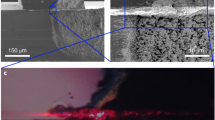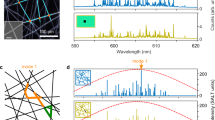Abstract
The development of nanoscale optical devices for classical and quantum photonics1,2,3,4,5 is affected by unavoidable fabrication imperfections that often impose performance limitations. However, disorder may also enable new functionalities6, for example in random lasers, where lasing relies on random multiple scattering7,8,9,10,11,12,13. The applicability of random lasers has been limited due to multidirectional emission, lack of tunability, and strong mode competition11 with chaotic fluctuations14 due to a weak mode confinement. The regime of Anderson localization of light15 has been proposed for obtaining stable multimode random lasing16, and initial work concerned macroscopic one-dimensional layered media17. Here, we demonstrate on-chip random nanolasers where the cavity feedback is provided by the intrinsic disorder. The strong confinement achieved by Anderson localization reduces the spatial overlap between lasing modes, thus preventing mode competition and improving stability. This enables highly efficient, stable and broadband wavelength-controlled lasers with very small mode volumes. Furthermore, the complex interplay between gain, dispersion-controlled slow light, and disorder is demonstrated experimentally for a non-conservative random medium. The statistical analysis shows a way towards optimizing random-lasing performance by reducing the localization length, a universal parameter.
This is a preview of subscription content, access via your institution
Access options
Subscribe to this journal
Receive 12 print issues and online access
$259.00 per year
only $21.58 per issue
Buy this article
- Purchase on Springer Link
- Instant access to full article PDF
Prices may be subject to local taxes which are calculated during checkout




Similar content being viewed by others
References
Baba, T. Slow light in photonic crystals. Nature Photon. 2, 465–473 (2008).
O'Brien, J. L., Furusawa, A. & Vučković, J. Photonic quantum technologies. Nature Photon. 3, 687–695 (2009).
Chang, D. E., Sørensen, A. S., Hemmer, P. R. & Lukin, M. D. Quantum optics with surface plasmons. Phys. Rev. Lett. 97, 053002 (2006).
Strauf, S. & Jahnke, F. Single quantum dot nanolaser. Laser Photon. Rev. 5, 607–633 (2011).
Noda, S. Seeking the ultimate nanolaser. Science 314, 260–261 (2006).
Sapienza, L. et al. Cavity quantum electrodynamics with Anderson localized modes. Science 327, 1352–1355 (2010).
Cao, H. et al. Random laser action in semiconductor powder. Phys. Rev. Lett. 82, 2278–2281 (1999).
van de Molen, K. L., Tjerkstra, R. W., Mosk, A. P. & Lagendijk, A. Spatial extent of random laser modes. Phys. Rev. Lett. 98, 143901 (2007).
Tureci, H. E., Ge, L., Rotter, S. & Stone, A. D. Strong interactions in multimode random lasers. Science 320, 643–646 (2008).
Gottardo, S. et al. Resonance-driven random lasing. Nature Photon. 2, 429–432 (2008).
Wiersma, D. S. The physics and applications of random lasers. Nature Phys. 4, 359–367 (2008).
Fallert, J. et al. Co-existence of strongly and weakly localized random laser modes. Nature Photon. 3, 279–282 (2009).
Leonetti, M., Conti, C. & Lopez, C. The mode-locking transition of random lasers. Nature Photon. 5, 615–617 (2011).
Mujumdar, S., Türck, V., Torre, R. & Wiersma, D. S. Chaotic behavior of a random laser with static disorder. Phys. Rev. A 76, 033807 (2007).
Anderson, P. W. Absence of diffusion in certain random lattices. Phys. Rev. 109, 1492–1505 (1958).
Stano, R. & Jacquod, P. Suppression of interactions in multimode random lasers in the Anderson localized regime. Nature Photon. 7, 66–71 (2013).
Milner, V. & Genack, A. Z. Photon localisation laser: low-threshold lasing in a random amplifying layered medium via wave localisation. Phys. Rev. Lett. 94, 073901 (2005).
Yang, J. et al. Lasing in localized modes of a slow light photonic crystal waveguide. Appl. Phys. Lett. 98, 241107 (2012).
Joannopoulos, J. D., Johnson, S. G., Winn, J. N. & Meade, R. D. Photonic Crystals: Molding the Flow of Light (Princeton Univ. Press, 2008).
Frank, R., Lubatsch, A. & Kroha, J. Theory of strong localisation effects of light in disordered loss or gain media. Phys. Rev. B 73, 245107 (2006).
Schwartz, T., Bartal, G., Fishman, S. & Segev, M. Transport and Anderson localisation in disordered two-dimensional photonic lattices. Nature 446, 52–55 (2007).
Gregersen, N., Suhr, T., Lorke, M. & Mørk, J. Quantum-dot nano-cavity lasers with Purcell-enhanced stimulated emission. Appl. Phys. Lett. 100, 131107 (2012).
Altug, O. & Vučković, J. Photonic crystal nanocavity array laser. Opt. Express 13, 8819–8828 (2005).
Smolka, S. et al. Probing the statistical properties of Anderson localisation with quantum emitters. New J. Phys. 13, 063044 (2011).
Thyrrestrup, H., Smolka, S., Sapienza, L. & Lodahl, P. Statistical theory of a quantum emitter strongly coupled to Anderson localized modes. Phys. Rev. Lett. 108, 113901 (2012).
Ramy, G. S., Dardiry, E. & Lagendijk, A. Tuning random lasers by engineered absorption. Appl. Phys. Lett. 98, 161106 (2011).
Garcia, P. D., Smolka, S., Stobbe, S. & Lodahl, P. Density of states controls Anderson localisation in disordered photonic crystal waveguides. Phys. Rev. B 82, 165103 (2010).
Apalkov, V. M. & Raikh, M. E. Universal fluctuations of the random lasing threshold in a sample of a finite area. Phys. Rev. B 71, 054203 (2005).
Tulek, A., Polson, R. C. & Vardeny, Z. V. Naturally occurring resonators in random lasing of π-conjugated polymer films. Nature Phys. 6, 303–310 (2010).
Loncar, M., Yoshie, T., Scherer, A., Gogna, P. & Qiu, Y. Low-threshold photonic crystal laser. Appl. Phys. Lett. 81, 2680–2682 (2002).
Garcia, P. D., Stobbe, S., Soellner, I. & Lodahl, P. Nonuniversal intensity correlations in a two-dimensional Anderson localizing random medium. Phys. Rev. Lett. 109, 253902 (2012).
Grgic, J. et al. Fundamental limitations to gain enhancement in periodic media and waveguides. Phys. Rev. Lett. 108, 183903 (2012).
Yamilov, A. & Payne, B. Classification of regimes of wave transport in quasi-one-dimensional non-conservative random media. J. Mod. Opt. 57, 1916–1921 (2010).
Acknowledgements
The authors thank E. Semenova for epitaxial growth. The authors acknowledge financial support from the Danish Council for Independent Research (Natural Sciences and Technology and Production Sciences), the European Research Council (ERC consolidator grant) and the Villum Foundation (NATEC centre of excellence).
Author information
Authors and Affiliations
Contributions
J.L. and M.S. carried out the optical experiments. S.E. and M.S. fabricated the sample. J.L. and P.D.G. analysed the experimental data. N.G., T.S. and J.M. developed the rate equation models. J.L., P.D.G, S.S. and P.L. wrote the manuscript. J.M., S.S. and P.L. supervised the project. All authors read and commented on the manuscript.
Corresponding author
Ethics declarations
Competing interests
The authors declare no competing financial interests.
Supplementary information
Supplementary information
Supplementary Information (PDF 1950 kb)
Rights and permissions
About this article
Cite this article
Liu, J., Garcia, P., Ek, S. et al. Random nanolasing in the Anderson localized regime. Nature Nanotech 9, 285–289 (2014). https://doi.org/10.1038/nnano.2014.34
Received:
Accepted:
Published:
Issue Date:
DOI: https://doi.org/10.1038/nnano.2014.34
This article is cited by
-
Tracking exceptional points above the lasing threshold
Nature Communications (2023)
-
Controlling random lasing action
Nature Physics (2022)
-
Controlling wave fronts with tunable disordered non-Hermitian multilayers
Scientific Reports (2021)
-
Engineered disorder in photonics
Nature Reviews Materials (2020)
-
Spectral super-resolution spectroscopy using a random laser
Nature Photonics (2020)



